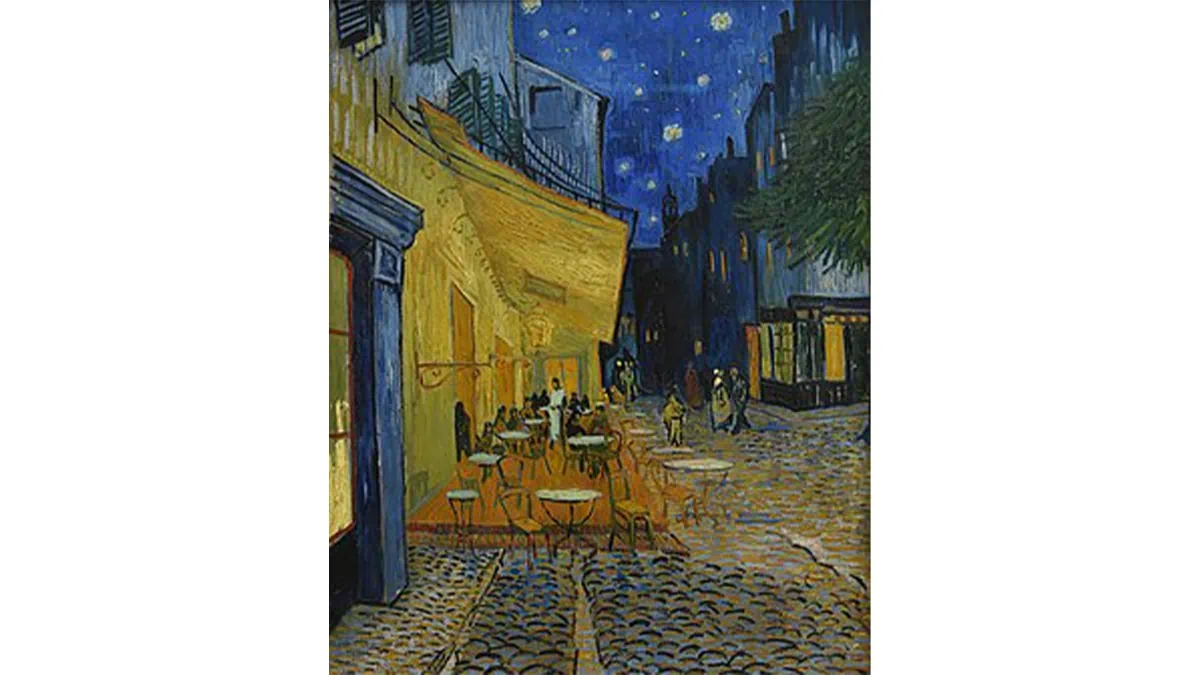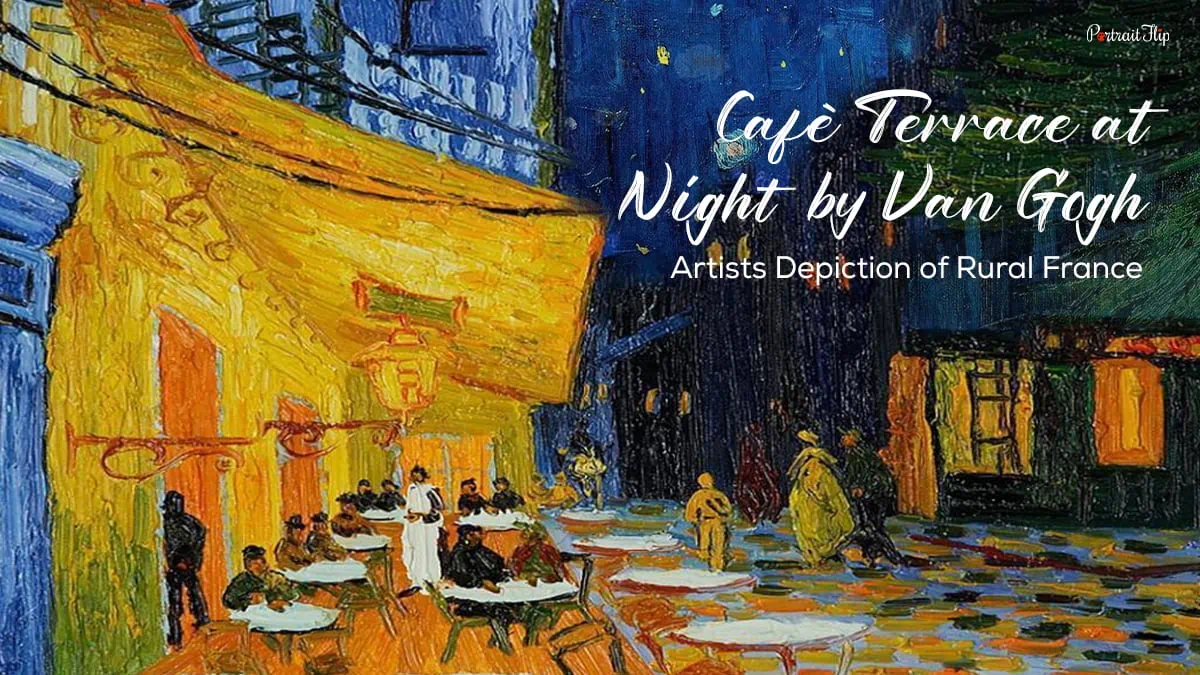Imagine you are in the streets of rural France, and it is nighttime.
You are sitting in a little street-side cafe with a book in your hand, and a cup of creamy espresso with a croissant is set on your table!
Despite being in a crowded cafe, you can still feel the solace in your own company!
You can see a few people taking a stroll and a few on the other tables; everyone is busy with their own lives!
This is what Van Gogh must’ve experienced right when he created Café Terrace at Night.
A masterpiece that is filled with a message that remains a mystery but decodes a lot of parts about Van Gogh’s perspective
Not only is this one of the most expensive paintings by Van Gogh, but it is also said to complete The Starry Night series.
This art has a depth to it, which we will now dive into together and discuss about this phenomenal artwork Café Terrace at Night by Vincent Van Gogh.
Table of contents
What is Café Terrace About?

Cafes have played a vital role in spreading the essence of France all over the world.
As in France, you can easily be mesmerized by the beauty of a simple bakery and a fancy and boujee cafe.
From art to food, France has set the standards high for the lovers of art and food!
Café Terrace at Night has its own tale to narrate.
It is believed that Van Gogh created this masterpiece by adding his touch of color in it.
He also focused on the fact that his usage of colors gave the painting a more realistic view and made the night full of hues.
He wrote to his sister, comparing the arrangement of various colors in his paintings: “like arranging jewels” because it “makes them shimmer and stand out through their contrasts.”
The popular café terrace at The Place du Forum in Arles, a charming village in the south of France, was the leading subject of this art.
Like many other ancient Roman cities, the Place du Forum in Arles was developed as the historical city center.
Fun fact, this painting was known by many names other than Café Terrace at Night, such as:
“The Café Terrace on the Place du Forum” in English and “Terrasse du café le soir”, also known as “Terrasse de café au place du Forum” in French and “Café Terras” in Dutch.”
Suggested Read: Art Deco Artists
The Prodigy Behind This Creation

Take a look at the painting and think for a while.
Don’t the brushwork and the theme of the painting seem familiar?
Now, if you are an aesthete like me, you will guess it correctly within a minute.
And for those of you who are still guessing, then let me tell you!
Café Terrace at Night is painted and curated by none other than the famous Dutch artist Vincent Van Gogh.
As a fact, Van Gogh underwent a lot of failures in his love life and financial life that resulted in his degrading mental health.
Now, the only way he was able to express his grief was by taking in the surroundings and painting them on the canvas.
He lived a rocky life, and it is also said that during one of his episodes with his mental health, when he was able to paint, he painted Café Terrace at Night.
His career was short-lived and full of potholes for his mental health, financial problems and love life!
Van Gogh still painted, and now many of his creations are housed in some of the world’s most prestigious museums.
Suggested Read: Almond Blossom by Van Gogh: The Painting of a New Beginning
Was It Really Painted at Night?

As the title of the painting suggests, Café Terrace at Night, a question that arises in my mind is, ‘Was it really painted at Night’?
It was a known fact that Van Gogh had a habit of stargazing and used to love the nighttime.
With this co-relation if you focus on the fact that Café Terrace at Night was one of the primary paintings from his series of artworks that sported starry backgrounds,
And when it comes to the background of paintings filled with darker hues and stars, it leaves us pretty evident with the conclusion that he had painted Café Terrace at Night in the nighttime.
Over time, when Van Gogh found his way into religion, he started star-gazing and developed a love for the night.
P.S: Van Gogh had also mentioned his passion for stars and the nighttime in one of his letters to his brother Theo.
Also Read: Famous French Artists
Analysis and Relationship With Post-Impressionism

The French art movement known as “Post-Impressionism” emerged approximately between 1886 and 1905.
Soon after the movement started getting attention from artists like Paul Gaugin, Edgar Degas, etc., Van Gogh, being one of the prominent curated some of the phenomenal post-impressionist art.
That was in 1888, when Van Gogh painted Café Terrace at Night.
He was known for his delusional paintings that delivered a sense of dilemma and were a depiction of his degrading mental health.
If you closely examine this artwork, you will observe the rough strokes of brush that almost give the painting the look of a jigsaw puzzle.
Moreover, Van Gogh’s color choice was filled with warmer and darker hues.
He was known for adding swirling effects in his paintings with the use of colors and strokes, and that is what can also be seen in Café Terrace at Night.
Together with his superb use of blue, violet, and green for the night, it also displays Van Gogh’s remarkable color gradation.
The artwork is characterized by elegant black outlines that pull everything together and give it a precise look.
Café Terrace at Night falls under the periods of Post-Impressionism and Cloisonnism.
Also, the composition’s numerous subjects are painted in a Cloissonist style.
Also Read: Famous Post-Impressionist Artists
Where is Cafe Terrace at Night Housed?

Are you a fan of Vincent Van Gogh and his creations?
Well, if you’d ask me, then I’d say I would be delighted to experience his artwork in person and admire his creations.
So, do you want to experience some of his renowned creations, along with Café Terrace at Night?
Then you should definitely visit the Kröller-Müller Museum in Otterlo, where Gogh’s creations have been safely housed.
And do you know how Van Gogh’s paintings land up in Otterlo?
The museum’s story has it that the founder of the Kröller-Müller Museum was a great admirer of Vincent van Gogh.
Not only this, Helene Kröller-Müller purchased some of his famous paintings for her art collection.
And now, the same art collection has been safely kept in the museum for years, and people from all over the world are welcome to admire the collection.
The Real Location Of The Muse

I have seen many artworks, but not many of them have intrigued me as much as Café Terrace by Van Gogh has.
Intrigued to know about Gogh’s muse for creating such a beautiful masterpiece that keeps you hooked!
Also, this makes me curious, and I am pretty sure that this question must’ve crossed your mind that is the location painted in this painting even a real place?
To your surprise, Café Terrace at Night was originally Café Terrace and exists at Place du Forum in Arles.
And the facts say that it is literally the same place where Van Gogh sat and painted his version of the scenery.
These days, the same cafe goes by the name Café Van Gogh and acts as a hub where all the Van Gogh fans gather and celebrate his art.
Wrapping Up
When we take a look at any artwork, there’s always more to what our eyes are able to see.
There’s always depth in it; an artwork is not just a painting! But there are a plethora of emotions and expressions.
This is also the case with the artwork by Van Gogh, Café Terrace at Night!
You might see a scene of a cafe at night, and you can also see people moving around in the streets.
But now that we have learned about the backstory of this artwork, we know that it is a visual representation of Van Gogh’s stressful life.
He created art to maintain his sanity and keep his mental health in balance.
And when an artist creates, they do so with passion, emotions and imagination!
The artist is the one who elevates emotions on a canvas and makes it worth the head turns and the discussions.
It is not necessary that every art make an impact on everyone’s mind, but every art is unique and sets the standards right.
With that being said, we at PortraitFlip also believe that every work of art is unique and should get the recognition it deserves.
And hereby, we present replicas of some of the famous paintings by legends of the art world.
You can check our page to know more about the same,
Author’s Epilogue
Hey lovely readers,
If you have made your way here, then thank you so much for staying till the end!
I really appreciate your curiosity to learn more the phenomenal artwork by Van Gogh, ‘Cafe Terrace at Night.’
We try our best to provide you with the most refined and researched information.
So, if you find this blog helpful, then do leave your valuable feedback in the comments.
Also, we are active on all the leading social media platforms, so come say hi to us right there.
We also post fun content on YouTube, so don’t forget to subscribe to that as well.
See you soon, dear readers!
Stay hydrated and stay safe.
Bye Bye!
FAQs
Café Terrace at Night is housed at the Kröller-Müller Museum in Otterlo.
Van Gogh painted this phenomenal piece of art in 1888.
The estimated price of this painting is around $200 million.
It is an oil painting by Van Gogh, and it falls under the periods of Post-Impressionism, Cloisonnism.





